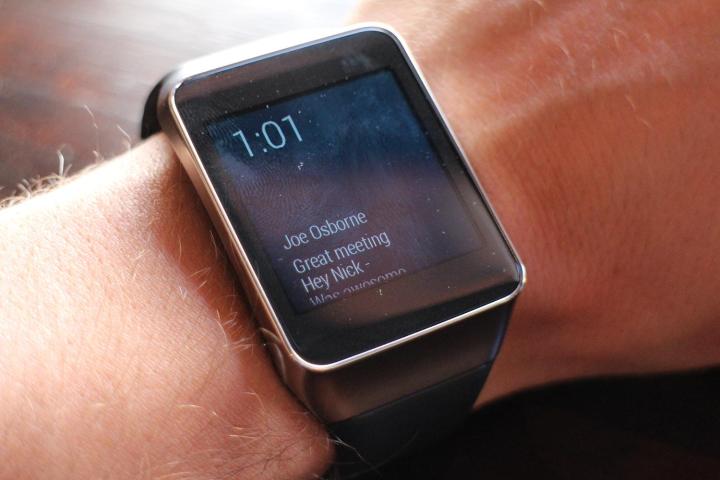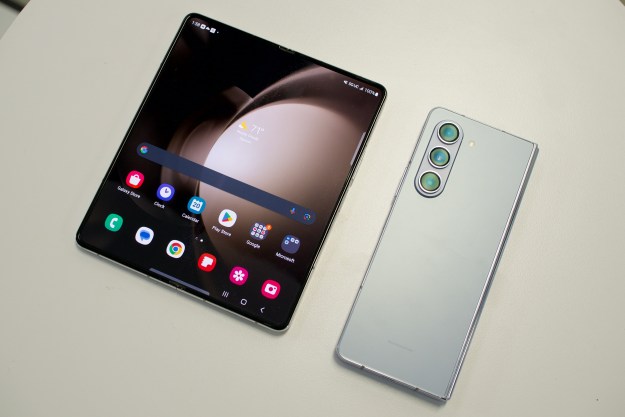Google claims the average Android user digs into his pocket 125 times a day to retrieve his phone. That’s either a sobering statistic about just how reliant we’ve become upon our smart devices, or a cue to make those devices even more accessible. Not surprisingly, Google took it as the latter.
Enter Android Wear, the Google platform specifically tailored to your wrist. From pinging you when text messages and emails arrive, to guiding you to the nearest coffee shop, Google wants you to keep your phone in your pocket and start using your watch.
Ending the turbulence of companies like Samsung and Sony churning out proprietary watches with proprietary operating systems that pair with only a few phones, Google has called order in the court with Wear. At long last, an app that runs on a Samsung watch will run on an LG watch, and they all work the same way.
So is it time to go full cyborg with a piece of tech that never leaves your wrist? We strapped on Samsung’s Gear Live to find out.
No one will think it’s a Rolex
Google may be promoting Android Wear with the sleek, circular Moto 360, but here’s a sobering reality check if you were hoping for a subtle smartwatch: It’s not here yet. Google promises it will arrive by fall. In its place, we have the Samsung Gear Live and LG G Watch, both of which adopt the square, slabbish profile of earlier efforts like the Galaxy Gear.

Neither is offensively geeky, but they won’t go unnoticed, either. These are big, flat screens clumsily clamped onto round wrists with steel and and silicone. Between the two, Samsung definitely has the smoother style thanks to a curvaceous bezel and more rounded wristband. LG seems to be embracing the squared-off look with a more brickish top and a wristband so simple it looks like it belongs on a toy. Fortunately, the standard 22mm watch band size will let you swap it out for any strap of your choosing. Blue alligator skin, maybe? If you’re rocking a smartwatch, you may as well embrace the attention.
Setup
Firing up the watch for the first time, you essentially get a pretty, square flashlight. Until you pair it with an Android phone, an Android Wear device will not so much as give you the time of day. Which is unfortunate because the setup process – at least with our developer preview units – was tedious and time consuming. We had to download no less than five Android applications to make it work, reboot the phone several times, and even after a successful pairing, the watch needed to chug down a fairly large firmware update before it worked. It’s possible these issues will be resolved by the time consumers get their hands on these devices in a few weeks, but at the very least you’ll need to download Android Wear and walk through a pairing process – it’s not as simple as adding a Bluetooth device. In that respect, it can hardly be considered an advancement from its proprietary predecessors, which also required special apps to talk to your phone.
Cue the cards
Without the spacious screen of a real Android device, Google had to rethink how to navigate on a screen so small, especially considering that your thumb can entirely blot out half of it. The solution was to make it work primarily through swipes and voice commands, rather than tapping tiny buttons. That means you’ll mostly interact with “cards,” which you can think of as an app with a linear layout that you can swipe through, rather than clicking around. Swiping up and down moves you through different cards. Swiping left and right brings you through different features of that card.
For instance, in the Fit app, the first page shows your step count along with a colorful graph for the week, the second shows your heart rate, and the third gives you a few settings you can turn on and off – the only page with any buttons to click. A series of tiny dots at the bottom of any given card indicate how many pages there are, and a hard swipe to the right dismisses a card entirely.
Speak up!
Scrolling up through all the open cards brings you to a home screen, which has the time and a wallpaper or watch face of your choosing. Tapping it (or saying “OK Google,”) prompts Wear to accept voice commands, such as “Navigate me to the nearest gas station,” or “Text Jason, I’m not going to able to make it this weekend.”
A pulsating Google logo shows it’s listening before it transcribes your utterances into text – pretty accurately. Like all voice recognition, a lot of background noise or crummy pronunciation can throw it off, but in general it picked up on what we were asking the first time around, and understands a natural way of phrasing things. For instance, you could command “Find me the nearest bar” or ask “Where is the nearest bar?” and get the same information.

Yet there are gaping holes: “Take a note drink more water,” makes a note, but “Show me my notes” won’t work to see said note. No, for that you need to know that they’re stored in an app called Keep. Easy to learn, yes, but not obvious. Android Wear still hasn’t reached the elusive Grandma Factor: I don’t think I could show my grandma how to talk to this watch and get it to do what she wants consistently.
What can it do?
The full suite of features on Wear right now includes alarms, notes, reminders, steps, heart rate, texts, email, agenda, navigation, compass, timer, and stopwatch. Or at least, we think. Without a grid of icons to survey everything in one place, it can be tricky to remember everything Wear can do. And a heavy reliance on voice means some features just aren’t accessible without knowing the right commands. In a pinch, you can swipe down from the voice-prompt screen to see some example commands.
The card-based system isn’t all aces, either. Android Wear largely decides on its own which cards you will get and when. If a new email arrives, you’ll get a card that lets you scroll through it on your watch, but dismissing it swipes it away forever. Other times, apps decide to stick around. Opening my calendar always left my next appointment peeking up at me from the bottom of the watch when I was done with it, and opening the Fit app left my step count for the day up. If I left both open, Google prioritized my next appointment over my step count without any obvious way to choose my steps instead.
When you let the watch sit, the LG model simply stays illuminated while the Samsung model goes into a low-power monochrome mode, displaying only the time and any pertinent notifications. Either marks a welcome upgrade from previous smartwatches, which required you to press a button just to get the time.
One of the more convenient, less advertised features is simply treating the watch like a Wikipedia on your wrist. All of the simple questions that Google would normally answer a the top of a search will show up directly on your wrist if you just ask, from how many miles are in 12,000 feet, to what rhubarb is.
Conclusion
In many ways, Android Wear feels more like a sophisticated pager than a true “smart” device in its own right. You won’t spend hours fiddling with it to explore its features because that’s not the point – Wear makes itself known when it has a reason to be known: an upcoming appointment, a new email, a route to the bank.
And it’s genuinely useful for those things.
For that reason, luddite fingerwaggers can breathe a sigh of relief: Wear will not usher in an era of people fiddling with their watches instead of their phones. There’s just not that much to do. If anything, it could restore some social harmony by allowing smartphone users to dispatch with simple tasks without dragging out the dreaded distraction boxes in their pockets. Take note, I/O protestors: Google might be doing us a favor here.
The relatively goofy styles of existing Wear watches and lack of apps should keep novices at bay for the moment, but time will fix both of those problems. While smartwatches will never be for everyone – anymore than regular watches were – don’t be surprised to see way more people talking to their wrists in the near future.
Editors' Recommendations
- Wear OS 4 is coming to your smartwatch this year — here’s what’s new
- Google wants you to know Android apps aren’t just for phones anymore
- Disappointingly, Wear OS 3 won’t be saving Android smartwatches for a while yet








